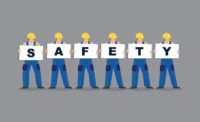The result of the current mess: many folks still in the lifeboat are doing more work than before, with fewer resources. Shifting (or sagging) market conditions require many to take on different tasks, perhaps without adequate training (as training budgets have been cut). While they are employed — for now — they carry around active concern for their own job.
This prolonged economic slump affects the home front as well. A working spouse will confront all the factors above. With plunging home values, the mortgage may be more than the house is worth — in some cases dramatically more.
The weight
An extraordinarily high level of stress weighs on folks in the workplace And years of research show that stress has major consequences for safety at work.
In earlier columns in this series (Oct. and Dec. 2006) I suggested that stress is a two-sided coin. Stress can activate and energize us; help us perform our very best. But beyond a certain threshold, stress can overwhelm us.
Stress in excess triggers a host of negative emotional states — anger, frustration, anxiety, depression, grief and disappointment, to name a few. These negative emotions not only make us feel bad; they link with some cognitive changes as well. Specifically, the negative emotions narrow and restrict thinking. They are likely to induce “tunnel vision.” We lose track, get distracted, miss steps….
Pressures and worried
Here is a scenario likely to play itself out in the current high-stress environment: Jack is an experienced maintenance man at his factory. Due to cutbacks, headcount in his shop has been reduced by 50 percent. Though the factory is down from three production shifts to one, severe budget reductions have shut down any hope of replacing aging plant equipment. Jack is busier than ever. On a typical day, he comes in two hours before the production shift starts up, and has a pile of work orders in front of him. He plunges in, working much faster than he used to, with less time to prepare. The pressure is great, but he cares about his job, his coworkers and his company.
Two hours into the production shift, four hours into Jack’s workday, one of the lines goes down, and he gets the call while he is in the middle of working solo on a repair on a pump. He hates to leave the pump half done, as it could mean more downtime. But the production line that is down accounts for more than a third of the product that is put out the door. When it is idled, twenty-five production workers are also idled. The down production line is the priority, even though the pump is still weighing heavy on his mind.
As Jack rushes over to the production area, he can’t help but think that his wife has been out of work now for going on six months. She is very concerned about finding work. The bills are piling up at home. Jack worries about keeping up even with the major ones, including the mortgage and two car payments. It has been too long since he actually slept through the night.
Jack gets to the production area and starts to diagnose the problem. He tells his friend Tom, who supervises the line, “I’ll get it back as quick as I can.” As he goes into the gear box for the line, it suddenly starts up. He pulls his hand back in the nick of time; no harm is done.
Jack calms himself after thinking what could have happened. “I know better than that,” he says to himself.
In a high-risk climate
Stress is a major contributing cause of errors and unsafe acts at work. I once heard an airline pilot say “the worst pilot to fly with is one who is having problems at home.” And the current economic environment has substantially raised the chronic, background level of stress on many of us.
The message to you? These are not “business-as-usual” times. We are in the red zone. We are in a very high-risk climate. It requires continuous vigilance and a heightened focus on safety. Our safety work is always important, but never more important than right now.
Safety pros are as prone as anyone else to feel the effects of the high-stress work climate. Why not? But now is the time to focus everyone, including ourselves, on doing our work carefully and doing it right. Reinforce even the basics, the most “obvious, commonsense” stuff. Remember, tunnel vision can cause us to miss even the fundamentals. How many times have you heard an injured worker in an accident review acknowledge, “I knew better than that… I just got distracted… took a shortcut… lost focus…”?
Observation is more critical than ever. In addition to direct personal observation, you can encourage supervisors and lead men — the ones who see the work being done on a moment-by-moment basis — to watch while their folks work. They need to make sure all are held accountable (and hold each other accountable) for best-practice safe behaviors at all times. Our safety work is always important, but never more important than right now.
As important as our safety role always is, now more than ever we need to ensure safety meetings actually activate safe behavior. We need to capture and learn from “near misses.” We need to support all employees to watch out for each other, and coach safe behavior. We need to keep the focus on safety.




